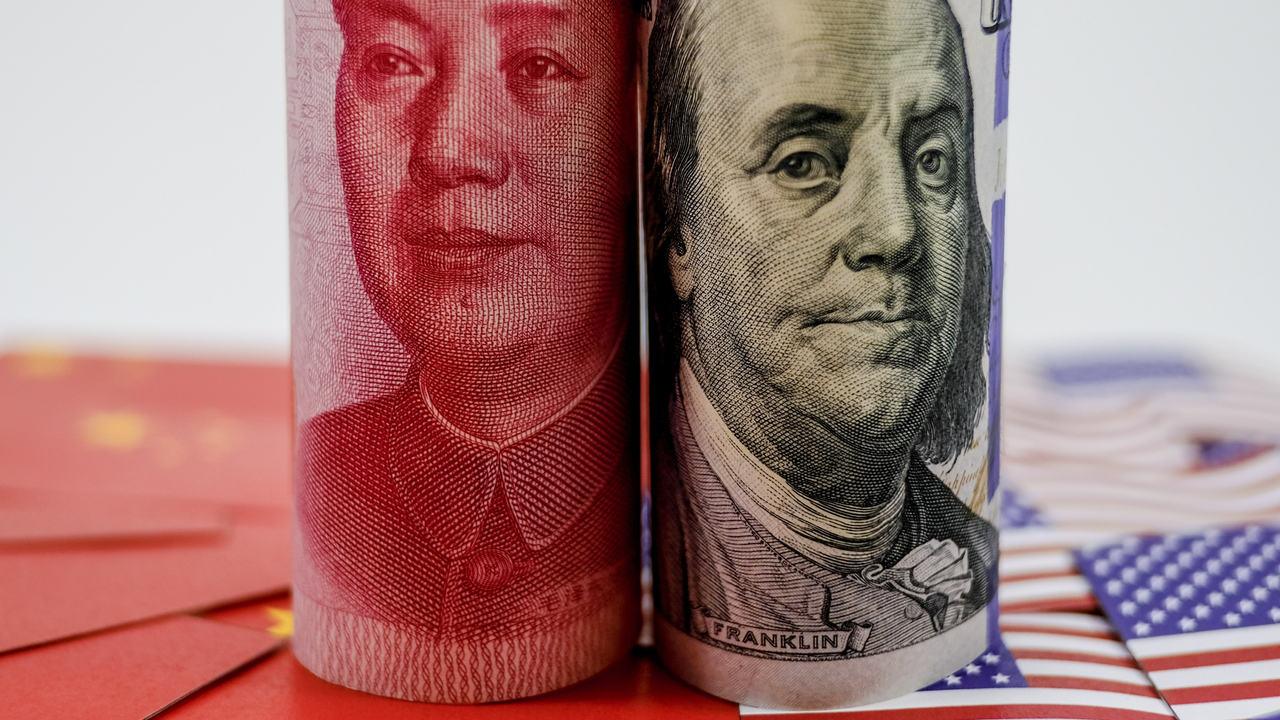The U.S. dollar so far has managed to withstand a withering assault upon its stability by modern monetary theory apologists and the profligate federal spending in response to the COVID-19 pandemic—record levels of inflation notwithstanding.
The dollar, which has been the world’s reserve currency and an integral instrument of U.S. power since the gold standard ended in 1971, is not invincible.
Escalating economic sanctions against the Russian Federation in response to President Vladimir Putin’s unprovoked aggression in Ukraine may sound the dollar’s death knell once and for all.
The hegemony of the dollar could deteriorate at least four ways, all of which are heavily correlated to the West’s economic sanctions regime: declining purchases of energy products with petrodollars, decreasing shares within foreign central banks, the rise of a Beijing-based alternative to the SWIFT network, and the emergence of a clear rival to the U.S. dollar in the digital yuan.
With the West having drawn a red line around direct military confrontation, there are two ways it has responded to the conflict to date: providing weapons and aid to Ukraine, and implementing a wide array of economic sanctions against Russia and many of its key elites.
Despite refusing to grant Ukraine more formidable weaponry such as aircraft and surface-to-air missile systems, the weapons NATO countries have sent—especially the anti-armor Javelin, Stinger, and NLAW shoulder-mounted missiles—have been tremendously effective.
The sanctions packages spearheaded by the Biden Administration have been decidedly less effective, neither constraining the Russian military nor pressuring Putin in any serious way. And, there seems to be little prospect that the war will end anytime soon. Chairman of the U.S. Joint Chiefs of Staff Mark Milley and NATO Secretary-General Jens Stoltenberg have claimed the conflict could last for years to come.
So, is the plan to simply keep this economic embargo going against Russia in perpetuity?
Countries at odds with U.S. economic interests—often including those who historically have felt the force of U.S. sanctions in the past—have become more inclined to cast off the yoke of the U.S. dollar. These “de-dollarization” efforts reduce the West’s leverage over their economic systems.
One of the primary pillars of dollar hegemony is the petrodollar system, which establishes the dollar as the uniform currency by which all global oil exporters accept payment.
U.S. sanctions on Russian energy imports threaten to supplant this system and give rise to a yuan-backed alternative, which has been heavily championed by China and a growing network of allies and partners.
The origins of this growing synthesis between Russia and China can be traced largely to a 2014 agreement that established large-scale currency swaps, new lines of financial credit, and greater energy cooperation. Not coincidentally, this partnership was incentivized by heavy U.S. sanctions imposed upon Russia in response to Putin’s first foray into Ukraine.
The crowning achievement of this cooperative effort was a 30-year deal struck between Russian natural gas conglomerate Gazprom and China National Petroleum Corporation (CNPC), leading to the construction of the Power of Siberia pipeline, which can supply China with 38 billion cubic meters of natural gas per year.
In 2021, China imported 1.6 million barrels per day of crude oil and 16.6 billion cubic meters of natural gas from Russia, accounting for 16 and 10 percent of its total imports.
Those totals could be greatly expanded, especially after a series of deals struck between Russian and Chinese energy companies during a February 2022 summit in Beijing.
Rosneft—Russia’s largest oil company, helmed by staunch Putin ally Igor Sechin—signed a 10-year agreement to deliver 200,000 barrels per day of crude oil to CNPC through an underutilized pipeline running through Kazakhstan.
Gazprom—run by Putin acolytes Alexei Miller and Victor Zubkov—agreed to supply 10 billion cubic meters of gas to CNPC over the next 30 years, through an entirely new pipeline running directly from eastern Russia to China.
Just as in 2014, the Biden Administration’s sanctions against Russia will galvanize deeper connectivity between the two autocracies.
In fact, within only a week of sanctions being imposed, Gazprom’s Miller signed a design contract for the Power of Siberia 2 project, an add-on to the existing PoS pipeline. PoS-2 will more efficiently connect China to Russia’s natural gas fields located mainly near the European border, and could furnish China with up to 38 billion cubic meters of gas.
The completion of PoS-2 would allow Russia to shift away from Western demand. And demand from China for natural gas and other energy products is virtually limitless; China’s worldwide natural gas imports rose by 20 percent in 2021. Moreover, China could decide to shift away from their other suppliers for more Russian crude.
This only further threatens the petrodollar system.
Fact is, Russian energy companies have already shifted away from demanding dollars for their products. Rosneft has settled payments in the euro since 2019, and Gazprom has begun settling payments in the yuan as of last year. Both moves are largely predicated upon insulation from U.S. sanctions, which have stung both companies before.
Second, countries within China’s growing sphere of influence have begun denominating energy products in their own currencies.
Independent Chinese refineries have begun paying for large quantities of cheap Russian crude with the Chinese yuan in under-the-table deals out of fear of provoking U.S. sanctions. China has also recently established an oil futures market tradable in the yuan, which has surged in popularity and given market participants a reason to use the yuan rather than the dollar.
Saudi Arabia—the world’s top exporter of crude oil—has escalated talks with China to price their oil sales in the Chinese yuan. India—another large importer of Russian crude—has been exploring using the Chinese yuan as a reference currency in its energy transactions.
These are all concerning signs for the petrodollar, and give greater credence to the threat of a “petroyuan” competitor.
Yet, the ramifications to the dollar based upon U.S. sanctions on Russian energy products represent only one part of the problem.
The other major area the Biden Administration’s sanctions have targeted is the Russian banking system.
Russia’s largest commercial banks have been kicked out of SWIFT, the Central Bank of Russia has had its foreign asset reserves blocked, and oligarchs’ western-based accounts have been frozen. Moreover, the U.S. Treasury has blocked Russia from making payments on its outstanding international debt in dollars, pushing Russia to the brink of default.
“Our goal from the outset has been to impose maximum pain on Russia, while to the best of our ability shielding the United States and our partners from undue economic harm,” Treasury Secretary Janet Yellen told a House committee this month.
Yet, they have done little damage to Russia while also threatening to do irreparable harm to the U.S. dollar.
According to the International Monetary Fund, the dollar’s share of global foreign reserves has decreased from 71 to 59 percent in the past 20 years, largely due to the de-dollarization efforts spearheaded by China and Russia.
Russia and China collectively have moved away from using the dollar since 2014’s sanctions in response to Putin’s first Ukrainian invasion and the 2018 trade war between the United States and China. In fact, from 2015 to 2020, bilateral transactions in dollars between Russia and China fell from 90 percent to just 46 percent.
In the dollar’s stead, the two countries have turned to the euro, the ruble, and the yuan. From 2013 to 2020, the Central Bank of Russia reduced its dollar reserves from 46.3 percent to 16.4 percent, simultaneously increasing its yuan reserves from 0.1 percent to 13.1 percent. In 2021, Russia announced plans to remove all dollar-based assets from its sovereign wealth fund.
Though Russia was the initial sponsor of a potential SWIFT alternative via its 2014 creation of SPFS, China’s CIPS has become the greater threat to SWIFT. Some officials have discussed merging SPFS into the more sophisticated CIPS. CIPS already includes nearly 1,300 financial institutions from more than 100 countries. And, it settles international transactions in the yuan, rather than the dollar.
Such a system could be seen as a highly attractive alternative to any country attempting to remove the yoke of western financial intervention. For example, India has recently explored such a system with Russia and China.
“We cannot allow China to become a safe haven for Russian firms seeking to avoid international sanctions,” argues lead bill sponsor Marco Rubio (R-Fla.). “My bill would make it nearly impossible for Chinese banks to access the U.S. financial system if they choose to interact with Russian banks using Chinese or Russian financial messaging systems.”
So, U.S. sanctions may now threaten Chinese and Russian, further incentivizing the Chinese to develop de-dollarization mechanisms.
As the IMF’s deputy managing director Gita Gopinath recently warned, the weaponization of financial sanctions on Russia will lead many countries to consider developing their own digital currency alternatives that are comparatively impervious to western intervention.
It is not a coincidence that China has rapidly scaled up its digital yuan pilot program over the past decade, which has become the most advanced central bank digital currency initiative in the world. Experts have predicted that the system—which is more than 10 years ahead of its closest competition—could challenge the U.S. dollar as early as this year.
A recent Carnegie paper details the attractiveness of such a system, which, “could allow its citizens to send money overseas by bypassing the current traditional payment infrastructure of correspondent banking. Citizens will not need to rely on costly commercial banks and messaging services like SWIFT for cross-border payments. The digital yuan could facilitate cross-border payment versus payment transactions by a simple exchange of tokens.”
In essence, China’s digital yuan is here to stay, highly effective, and will become more attractive to countries on the receiving end of U.S. sanctions. Every day, the West continues its siege against the Russian financial system.
China’s goal of eclipsing the United States in global power is based upon its subversion of the U.S. dollar and replacing it with a heavily internationalized yuan–or renminbi, to use its official name when used as a medium of international exchange. Unless one relishes the opportunity to use a digital Chinese currency programmable and controllable by the Chinese Communist Party, it would be wise to consider options that do not degrade the dollar’s international standing.
The international community continues to heap new sanctions on top of existing ones. If anything, sanctions should be scaled back. Or, if politically untenable, sanctions should not escalate any further than they already have. The problem is not that using sanctions to completely isolate Russia would be unsuccessful; such a strategy could very well work if it were possible.
The problem is, full isolation of Russia is exceedingly unlikely. Continuing to isolate Russia from the West only increases its synergies with the East, nullifying sanctions’ effects and doing long-term damage to Western economies.
Energy sanctions will not work as long as Europe remains a steady customer of Russian oil and gas, as it will be until at least 2027, according to European Commission President Ursula von der Leyen. In fact, Russia is set to make even more money on its energy exports in 2022 than last year. Banking sanctions will not work as long as Russia continues to gain income from its exports to pay its debts, and find other financial avenues.
Vladimir Putin is the enemy, not the entire Russian economic infrastructure. His aggression requires a response, just not the response that is simultaneously least effective, most costly, and poses the greatest long-term threat to U.S. strategic interests.
First published at: American Greatness.
Photo from GettyImages.
Jack McPherrin is the managing editor of 1818 Magazine. Jack works as the research editor for the Editorial Department of The Heartland Institute, where he also contributes to the mission of the Socialism Research Center as a research fellow. He is in the final stages of completing his Master’s Degree in International Affairs from Loyola University-Chicago, where his myriad research interests primarily encompass domestic and international economic policy, global institutions, authoritarian regimes, and foreign affairs - with a particular emphasis upon Russia and China. Prior to his graduate pursuits, Jack spent six years in the private sector after graduating from Boston College with a dual Bachelor's Degree in Economics and History. He currently resides in the Lincoln Park neighborhood of Chicago, a few short miles from where he was raised.








